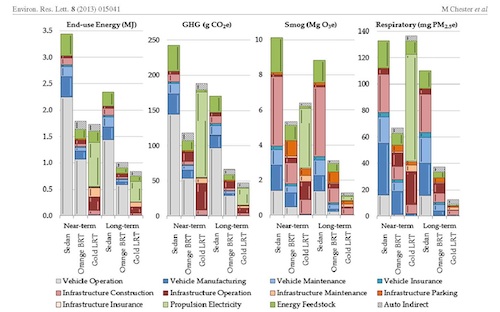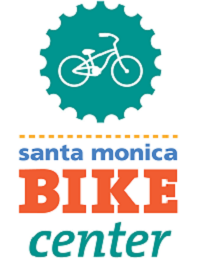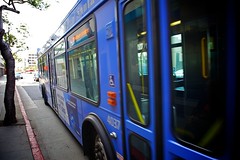Santa Monica: Improving Bus Service is an Imperative to Meet Our Sustainability Commitments
11:30 AM PDT on May 23, 2013

This week a UCLA research team (that included our own board member and contributor Juan Matute), published their findings on life-cycle green house gas emissions impacts, energy use, smog & respiratory particulates of public transit compared with driving, using the Metro Gold Line train and Orange Line bus rapid transit corridor as case studies.
In some ways the paper highlights pretty intuitively obvious conclusions, but having the supporting evidence and the details matter. For example new light rail systems in the short term have a greater impact than a BRT busway, but edges out emissions and energy efficiency in the long term. The mix that goes into our electric grids weighs heavily on the operating energy demand of light rail, and if the emissions of the grid can be lowered, it will lower the impact of running electric transit systems. However improvements to the bus system can be made on a faster timeline at lower upfront cost, and rail requires a greater corridor ridership to be justified. These are all important factors to consider in the timeline horizons of various emission goals.
One of my takeaways from this is that if environmentalists and communities with sustainability goals such as Santa Monica has, are really serious, bus systems deserve a lot more attention and resources than they are typically given. Every new electric vehicle, especially "sexy" ones like the Tesla, nets endless fawning attention on so many "green" blogs, while the real work horses of efficient transportation, city buses, are barely given any attention at all. We could reduce the emissions and energy use of transportation a lot more, and a lot faster with striping more dedicated right of ways for buses, than we could ever get waiting for the slow attrition of inefficient private automobiles being churned through over the many years U.S. fleet turn over takes.
One of the great under appreciated local success stories has been the "Any Line, Any Time" program for SMC students, faculty and staff, that was just renewed for another year. The college bundles the cost of bus fare with a deal with the city (and some cost recovery on student fees), and everyone from SMC has free bus fare on the entire BBB system. In effect it treats bus ridership more like the way many businesses and institutions treat providing car parking through bundling costs. The number of students getting to campus without driving has grown to more than half, largely driven by the success of the bus ridership, and an impressive feat especially given how few students of SMC even live within Santa Monica's borders.
It frustrates me when people who ought to know better discuss public transit in Santa Monica in the future tense. That transit oriented development or any measures or policies that relax the mandates that support and favor driving now would be premature until the Expo Line train is running, or not even then because one transit line "isn't a real system".
The implications of such thinking are essentially that the bus system doesn't exist (or at least doesn't exist to their privileged windshield view). That somehow the people already riding the bus are irreverent or don't count (BBB alone typically runs around 70,000 trips a day on top of overlapping Metro service). The common practice of transfers between buses & trains aren't really a thing in this world view. That the bus system can be improved in efficiency, comfort, and convenience to serve a greater number of people at a better level of service isn't even a thought, let alone on the table. Such thinking is wrong headed on all accounts, but pervasive enough that it obstructs the potential for buses system enhancements that could further reduce transportation greenhouse gas emissions in tandem with the development of longer term investments like the light rail network construction.
The city of Santa Monica supports the Big Blue Bus pretty well, and all things considered it's a good system that I've made ample use of since 2002 when I started attending college on the Westside. But when I look at the resources we devote to drivers by comparison, it's quite a disparity. No expense is spared on new parking garages, parking counter systems way finding, and real time data, while plans to upgrade bus stops and shelters have languished for years with nothing to show for it. When we roll out the red carpet for driving in Santa Monica but most of bus stops don't even have any shade let alone functional shelter for when our weather does arrive (yes transit station and stop designers, it does rain in Southern California, and shade is nice in the summer), our actions don't really reflect the values we have down on paper.
Lost in all the center-fold style spreads of costly EV's all over the U.S. environmental blogosphere, there is precious little honest confrontation with the numerous car culture impacts that transcend energy source; such as sprawling land use, traffic congestion, fatalities and inaccessibility for people who cannot drive, do not want to, or can't afford vehicle ownership. The car industry has the biggest advertising budgets in the world, they don't really need any help to sell more cars (and are increasingly pushing debt accumulation to boost sales).
So can we please get some more love for the bus from environmentalists? We've passed many documents in this city on a commitment to sustainability, but if we can't build the support needed to move forward on peak hour bus lanes on Lincoln, or other desperately needed bus system improvements, we're really missing the boat. Actions always speak louder than words, and transportation is our most significant source of green house gas emissions. We also apparently under count transportation in our present carbon accounting models as I've learned in talking with climate researchers like Juan Matute, so our pie graph really should lean even heavier toward transportation. Seeing 400ppm of CO2 recorded at Mauna Loa Hawaii should be a wake up call, the clock is ticking.
Stay in touch
Sign up for our free newsletter
More from Streetsblog Los Angeles
Eyes on the Street: New Lincoln Park Avenue Bike Lanes
The recently installed 1.25-mile long bikeway spans Lincoln Park Avenue, Flora Avenue, and Sierra Street - it's arguably the first new bike facility of the Measure HLA era
Brightline West Breaks Ground on Vegas to SoCal High-Speed Rail
Brightline West will be a 218-mile 186-mile-per-hour rail line from Vegas to Rancho Cucamonga - about 40 miles east of downtown L.A. - expected to open in 2028
This Week In Livable Streets
Active Streets Mission-to-Mission, LAPD reports on its use of force in 2023, Pasadena Transit plans, Metro subway construction, and more







